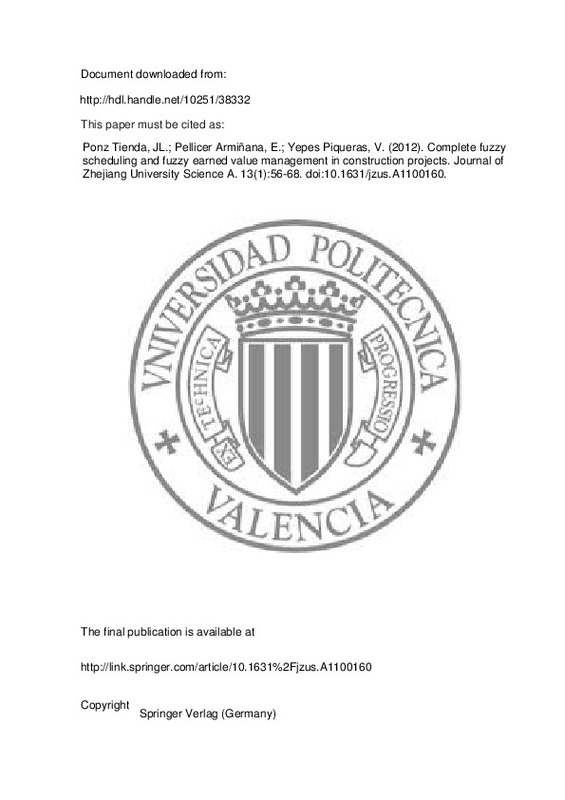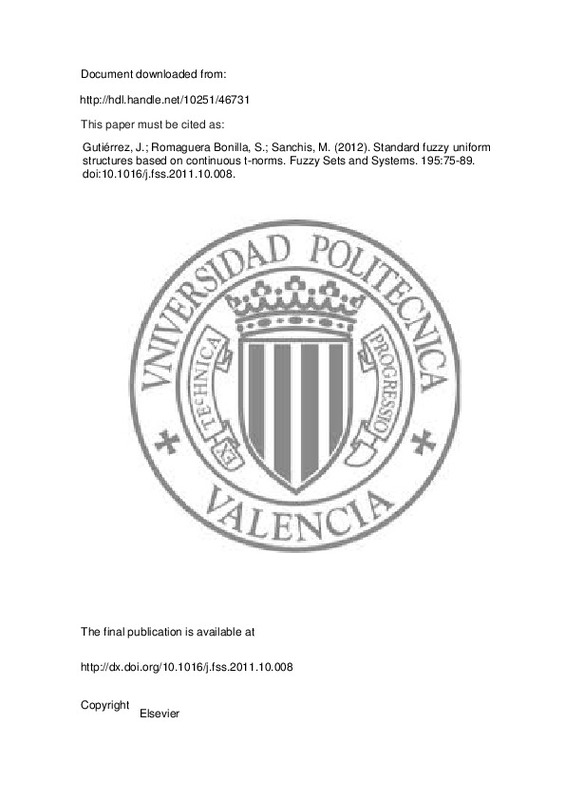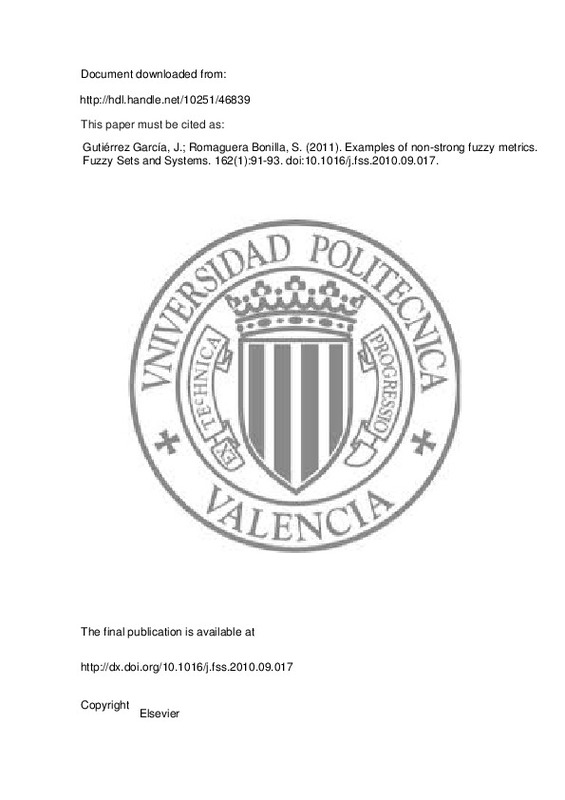JavaScript is disabled for your browser. Some features of this site may not work without it.
Buscar en RiuNet
Listar
Mi cuenta
Estadísticas
Ayuda RiuNet
Admin. UPV
Complete fuzzy scheduling and fuzzy earned value management in construction projects
Mostrar el registro sencillo del ítem
Ficheros en el ítem
| dc.contributor.author | Ponz Tienda, José Luis
|
es_ES |
| dc.contributor.author | Pellicer Armiñana, Eugenio
|
es_ES |
| dc.contributor.author | Yepes Piqueras, Víctor
|
es_ES |
| dc.date.accessioned | 2014-06-24T13:17:06Z | |
| dc.date.issued | 2012-01 | |
| dc.identifier.issn | 1673-565X | |
| dc.identifier.uri | http://hdl.handle.net/10251/38332 | |
| dc.description.abstract | Complete fuzzy scheduling and fuzzy earned value management in construction projects Por: Luis Ponz-Tienda, Jose; Pellicer, Eugenio; Yepes, Victor JOURNAL OF ZHEJIANG UNIVERSITY-SCIENCE A Volumen: 13 Número: 1 Páginas: 56-68 Fecha de publicación: JAN 2012 Search For Full Text Cerrar abstractCerrar abstract This paper aims to present a comprehensive proposal for project scheduling and control by applying fuzzy earned value. It goes a step further than the existing literature: in the formulation of the fuzzy earned value we consider not only its duration, but also cost and production, and alternatives in the scheduling between the earliest and latest times. The mathematical model is implemented in a prototypical construction project with all the estimated values taken as fuzzy numbers. Our findings suggest that different possible schedules and the fuzzy arithmetic provide more objective results in uncertain environments than the traditional methodology. The proposed model allows for controlling the vagueness of the environment through the adjustment of the alpha-cut, adapting it to the specific circumstances of the project. © Zhejiang University and Springer-Verlag Berlin Heidelberg 2012. | es_ES |
| dc.description.sponsorship | The authors want to thank Ms. Doria GIL-SENABRE, Universitat Politecnica de Valencia, Spain, for the support provided. | en_EN |
| dc.language | Inglés | es_ES |
| dc.publisher | Springer Verlag (Germany) | es_ES |
| dc.relation.ispartof | Journal of Zhejiang University Science A | es_ES |
| dc.rights | Reserva de todos los derechos | es_ES |
| dc.subject | Earned value method (EVM) | es_ES |
| dc.subject | Fuzzy logic | es_ES |
| dc.subject | Fuzzy set | es_ES |
| dc.subject | Project management | es_ES |
| dc.subject | Scheduling | es_ES |
| dc.subject | Construction projects | es_ES |
| dc.subject | Earned value | es_ES |
| dc.subject | Earned value management | es_ES |
| dc.subject | Fuzzy arithmetics | es_ES |
| dc.subject | Fuzzy numbers | es_ES |
| dc.subject | Fuzzy scheduling | es_ES |
| dc.subject | Project scheduling | es_ES |
| dc.subject | Traditional methodologies | es_ES |
| dc.subject | Uncertain environments | es_ES |
| dc.subject | Budget control | es_ES |
| dc.subject | Fuzzy sets | es_ES |
| dc.subject | Mathematical models | es_ES |
| dc.subject | Value engineering | es_ES |
| dc.subject.classification | CONSTRUCCIONES ARQUITECTONICAS | es_ES |
| dc.subject.classification | INGENIERIA DE LA CONSTRUCCION | es_ES |
| dc.subject.classification | PROYECTOS DE INGENIERIA | es_ES |
| dc.title | Complete fuzzy scheduling and fuzzy earned value management in construction projects | es_ES |
| dc.type | Artículo | es_ES |
| dc.embargo.lift | 10000-01-01 | |
| dc.embargo.terms | forever | es_ES |
| dc.identifier.doi | 10.1631/jzus.A1100160 | |
| dc.relation.projectID | info:eu-repo/grantAgreement/MICINN//BIA2011-23602/ES/DISEÑO EFICIENTE DE ESTRUCTURAS CON HORMIGONES NO CONVENCIONALES BASADOS EN CRITERIOS SOSTENIBLES MULTIOBJETIVO MEDIANTE EL EMPLEO DE TECNICAS DE MINERIA DE DATOS/ | es_ES |
| dc.rights.accessRights | Abierto | es_ES |
| dc.contributor.affiliation | Universitat Politècnica de València. Departamento de Construcciones Arquitectónicas - Departament de Construccions Arquitectòniques | es_ES |
| dc.contributor.affiliation | Universitat Politècnica de València. Departamento de Ingeniería de la Construcción y de Proyectos de Ingeniería Civil - Departament d'Enginyeria de la Construcció i de Projectes d'Enginyeria Civil | es_ES |
| dc.description.bibliographicCitation | Ponz Tienda, JL.; Pellicer Armiñana, E.; Yepes Piqueras, V. (2012). Complete fuzzy scheduling and fuzzy earned value management in construction projects. Journal of Zhejiang University Science A. 13(1):56-68. https://doi.org/10.1631/jzus.A1100160 | es_ES |
| dc.description.accrualMethod | S | es_ES |
| dc.relation.publisherversion | http://link.springer.com/article/10.1631%2Fjzus.A1100160 | es_ES |
| dc.description.upvformatpinicio | 56 | es_ES |
| dc.description.upvformatpfin | 68 | es_ES |
| dc.type.version | info:eu-repo/semantics/publishedVersion | es_ES |
| dc.description.volume | 13 | es_ES |
| dc.description.issue | 1 | es_ES |
| dc.relation.senia | 206906 | |
| dc.contributor.funder | Ministerio de Ciencia e Innovación | es_ES |
| dc.contributor.funder | European Regional Development Fund | es_ES |







![[Cerrado]](/themes/UPV/images/candado.png)




